By Halima-Tus-Sadia, Head of Growth and Numair Reza Khan, Communication Intern at Spreeha Foundation
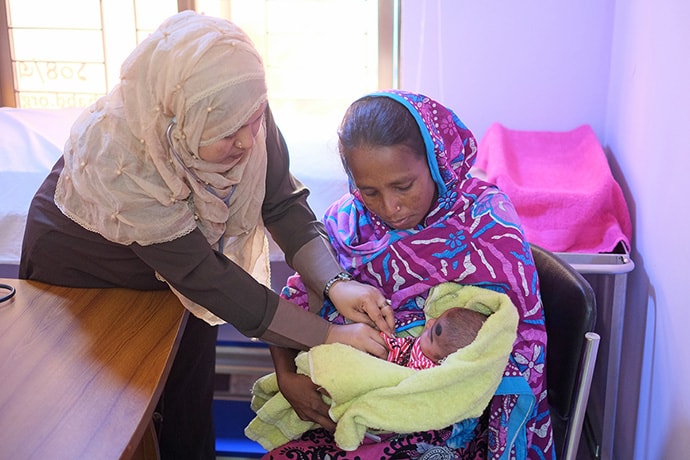
Doctor consultation at urgent health center. Photo: Spreeha Foundation
The Healthcare Maze in Bangladesh
Welcome to the intricate world of healthcare in Bangladesh, where each aspect tells a tale of challenge and strength.
Imagine a country where there are only 7 doctors for every 10,000 people, much lower than what the WHO recommends. Tertiary hospitals strain under the weight of overcrowding and limited resources, where a mere 48 seconds is all a patient gets for consultation on average. You’d have more time to microwave your popcorn than to discuss your health concerns.
Picture the impact: rushed diagnoses, overlooked symptoms, and delayed interventions. Meanwhile, a proliferation of unregulated pharmacies and diagnostic centers casts a shadow over public health efforts, peddling counterfeit drugs and erroneous diagnoses.
But it’s not just infrastructure and resources that are lacking. There’s a deeper issue at play—a reactive approach to health-seeking behavior prevails, with individuals only seeking medical attention when symptoms become undeniable. This delay leads to late-stage diagnoses, escalating treatment costs, and needless suffering. Financial burdens add yet another layer of complexity, with a staggering 74% of healthcare expenses being shouldered out-of-pocket. Families strain under the weight of medical bills, with no safety net in the form of health financing or insurance. While strides have been made towards digitizing the healthcare system, with macro-level information now available, individualized Electronic Health Records (EHR) is still a distant dream. With many gaps to fill, the Bangladesh Government has made the bold decision to ensure universal health coverage by 2032 and is accelerating to strengthen our overall health system to meet the target of SDG 3: Good Health and Well-being.
Way out of the maze: Tech-enabled hyper-local urgent health network
For the past ten years, Spreeha has been deeply involved in the healthcare sector, especially in helping communities that often get overlooked. Since 2013, we have been running a primary healthcare center right in the heart of the slums. Our primary focus has been on providing convenient access to doctor consultations, safe medications, and high-quality diagnostics to the slum population within their own neighborhoods. Our dedicated community mobilizers have diligently gone door-to-door, advocating for lifestyle changes and promoting healthy choices in everyday living.
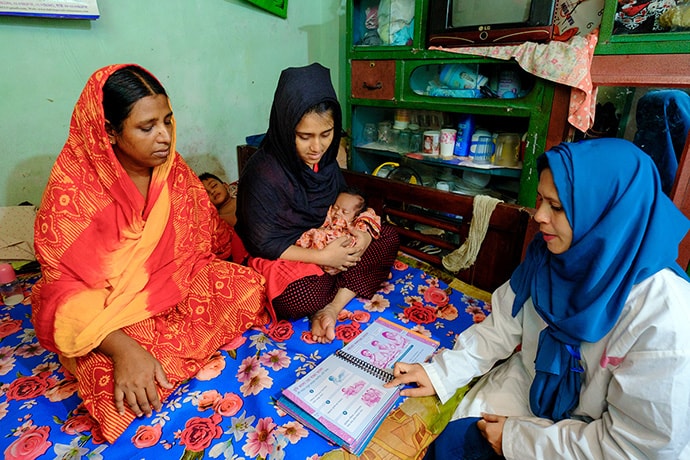
Home visit to ensure post-delivery care. Photo: Spreeha Foundation
We have been keeping a close eye on what sicknesses pop up during different times of the year and implemented preventive measures based on the data. This approach allowed us to effectively navigate through the challenges posed by the COVID-19 pandemic and successfully contain the spread of infection. Within 10 years, we impacted the lives of 400,000 people through our healthcare initiatives.
However, following the significant impact of the global pandemic in 2020, relying solely on donations did not seem like a solid plan anymore. Additionally, the people we help still lack the financial means to access expensive health services. This presented us with a double challenge – alongside delivering top-notch healthcare, we had to reconsider how to ensure our clinic could remain financially stable and expand its reach.
But every cloud has a silver lining, right?
This tough spot gave us a chance to grow. We figured, why not use technology and smart health service design tricks to take what we have learned and spread it to more places that need it? Grabbing the opportunity, we set out to devise a solution that would enable us to break free from donor dependency while ensuring continued access to affordable healthcare.
Our answer?
The development of tech-enabled hyper-local urgent health centers, strategically designed to cater to the immediate healthcare needs of our communities. Our vision extends beyond a single center—we are planning to establish a network of these innovative facilities where each center will be led by a trained native health professional and will become financially sustainable after 12 months of supported operations.
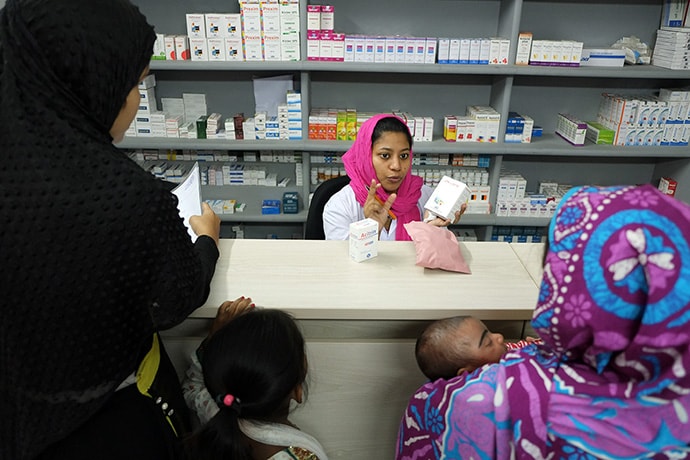
Safe medication counseling at urgent health center. Photo: Spreeha Foundation
So, how are we getting out of the healthcare maze?
- Bringing local health professionals to the forefront: We are empowering local paramedics, nurses, and medical technologists to lead our centers, ensuring they are staffed with certified professionals capable of providing high-quality urgent care. This approach reduces sole reliance on doctors for treatments and alleviates the burden on the overall healthcare system. It also guarantees that our centers are managed by trained professionals, rather than unqualified individuals, maintaining the highest standards of safe medication and healthcare quality. Additionally, we are creating meaningful income opportunities for these healthcare professionals while fostering strong community trust in our services, as they are native to the localities they serve.
- Improving access to quality healthcare: Our centers are strategically positioned within communities, ensuring residents within a 1-kilometer radius can easily reach us within a 10–15-minute walk from their homes. This proximity facilitates convenient access to doctor consultations, safe medications, quality diagnostic tests, and urgent treatments.
Led by trained health professionals, our centers promptly address minor injuries like cuts and burns, providing services such as nebulization, dressing, and first aid. By managing less severe cases locally, we alleviate strain on tertiary hospitals. Serious conditions are referred to our in-house general physician for further treatment and counseling, ensuring appropriate care without overwhelming higher-level facilities.
Moreover, our centers prioritize maternal and child health, with gynecologists and pediatricians available to serve the 70% of our female beneficiaries. By addressing common health issues within the community, we enhance access to quality care, alleviate hospital overcrowding, and allow doctors to devote more time to each patient, thereby enhancing overall healthcare efficiency.
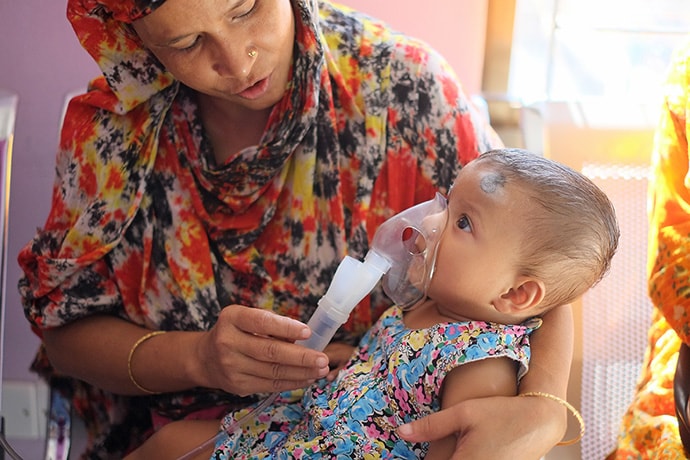
Nebulization at urgent health center. Photo: Spreeha Foundation
We ensure safe medication through sourcing from reputable pharmaceuticals, maintaining temperature-controlled environments, and providing patients with guidance on proper medication intake.
Another distinguishing factor that makes our solution unique is our commitment to quality diagnostics for our patients at affordable prices. We are in partnership with AmarLab, an innovative at-home diagnostic test company. AmarLab’s trained sample collectors gather samples at our center and use advanced transportation technology to ensure sample quality. These diagnostic tests are conducted with certified hospitals, ensuring both accuracy and reliability of reports, unlike in local diagnostic centers, ensuring that our patients receive the necessary treatment. Additionally, we offer to send these reports directly, saving a patient’s time and money on transportation.
- Promoting proactive healthcare: We keep watch on the local disease trends and organize campaigns for early detection of diseases. Our community health workers go door-to-door to raise awareness about healthy lifestyle and treatments. They offer at-home screening and treatment for home-bound patients and connect them to our doctors through telemedicine portal, if necessary. By offering education, screening services, and early intervention programs, we empower individuals to prioritize their health and seek medical attention before conditions escalate, thereby reducing the burden of late-stage diagnoses and complex treatments.
-
Using the power of technology: We maximize tech tools for efficient healthcare delivery. We use field reporting technology to gather real-time data from the field, enabling prompt decision-making and targeted interventions. Community health workers equipped with mobile devices collect vital information during their interactions with patients, providing valuable insights into prevalent health issues and community needs. This data-driven approach facilitates proactive healthcare management and resource allocation, ultimately improving health outcomes.
- We conduct remote monitoring of our inventories for better and prompter business decisions, to reduce wastage, and to ensure the quality of our services.
- We use sample logistic technology by our partner AmarLab. Utilizing advanced tracking systems and temperature-controlled logistics, samples are efficiently transported from collection points to diagnostic facilities, ensuring sample integrity and timely results.
- We maintain electronic health records (EHRs) for all patients, providing a repository of their medical history, treatments, and diagnostic reports for informed decisions. This digital platform enables seamless information sharing among healthcare providers, enhances care coordination, and empowers patients to actively participate in their healthcare journey.
- We keep watch on local disease trends through data analytics tools and analyze patterns to enable proactive healthcare planning and targeted interventions. This data-driven approach enhances surveillance capabilities, strengthens public health responses, and ultimately improves community health outcomes.
- Reducing healthcare costs: To reduce healthcare costs, we adopted a B2B model, offering significant discounts on services to patients from underserved communities. We have partnerships with reputable pharmaceutical companies for discounts on medicines, vaccines, and medical supplies. Additionally, our diagnostic logistics partner, AmarLab, collaborates with esteemed diagnostic labs and hospitals, ensuring cost-effective and high-quality diagnostic tests. This model has helped us to reduce costs for underserved patients by 50% in the last 1 year for 21,000 patients.
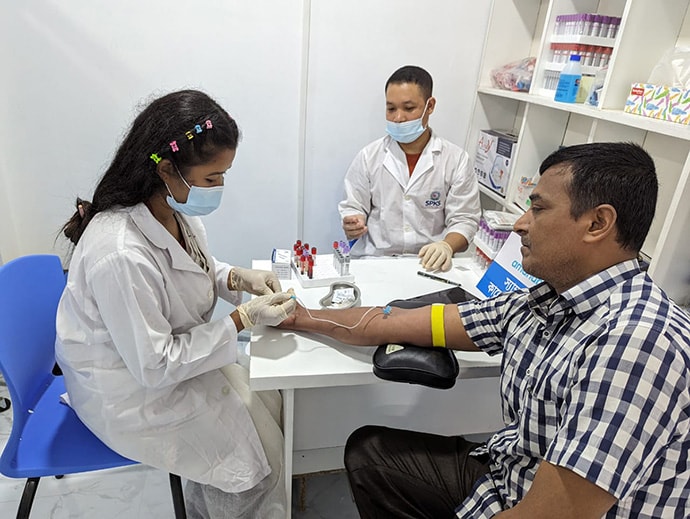
Sample collection at urgent health center. Photo: Spreeha Foundation
Our Commitment to Impact
Our commitment is to establish a sustainable network of hyper-local tech-enabled urgent care centers across Bangladesh, ensuring accessible, affordable, and quality healthcare for 6.2 million people in underdeveloped areas by 2028. As of December 2023, we have impacted more than 400,000 people with our healthcare initiatives. In 2023 alone, we have established 6 community-led tech-enabled urgent care centers in Dhaka and Gazipur, each equipped to serve 20,000 patients annually.
By 2028, we aim to create a network of 100 urgent care centers, prioritizing direct access to healthcare professionals, affordable medication, vaccines and diagnostics, e-health records, AI-driven treatment decisions, and home-based services.
To make our big dream a reality, we have developed a multi-layered funding model. We seek support from individuals, foundations, corporations, and big bet funders. With a one-time contribution of USD 10,000, anyone can sponsor the operation of one urgent healthcare center for a year. Following this initial support, the center becomes self-sustainable, serving the community independently from year 2.
Donate Now: https://www.globalgiving.org/projects/provide-healthcare-for-underserved-communities/
Watch our healthcare hero’s story: https://www.youtube.com/watch?v=NtiUUkLYVYQ
Get a virtual tour of our Urgent Health Center: https://www.youtube.com/watch?v=PrZ6S_c6huc